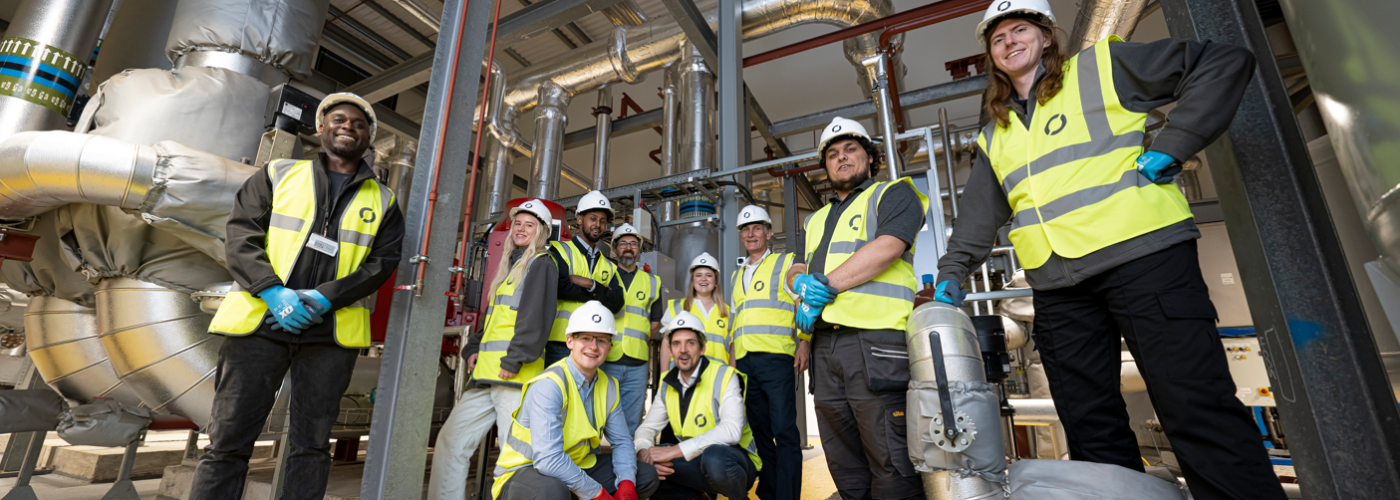Five more projects have been awarded over £57 million from the Government’s Green Heat Network Fund (GHNF). These projects, integral to comprehensive urban renewal plans, will provide sustainable, low carbon heat to 17,000 new homes, commercial spaces, and public buildings, contributing to vibrant, future-proofed communities. Expected to save over 385,000 tonnes of CO2, these networks will help to ensure that urban developments lead the way in sustainable living[1]. This investment demonstrates the UK’s commitment to modernising its urban areas for resilience, sustainability and future regulations, whilst helping to deliver the Government’s mission of clean power by 2030 and accelerate plans towards net zero.
Heat networks present a fantastic opportunity to expand access to low carbon heating and provide a cost-effective solution for decarbonising dense urban areas. The funding will also help new developments to meet mandated requirements under the Future Homes and Buildings Standard, as the Government seeks to improve the energy efficiency of new buildings. By using a range of innovative low carbon heat sources, these networks will ensure that new residents benefit from reduced heating bills and lower carbon footprints.
Today, GHNF is providing over £57 million to support the commercialisation and construction of five heat network projects connecting to major developments:
- Leeds will be awarded £24.5 million for an extension to the LeedsPIPES network. The South Bank extension, located in one of Europe’s largest brownfield regeneration sites, will allow an additional 8,000 homes and buildings to connect to the low carbon heat network, powered using a local source of waste heat.
- Three projects across London will receive £20.2 million to connect 8,500 new homes and businesses across new developments to low carbon heat networks powered by air and ground source heat pumps. This includes the vibrant Clapham Park and Brent Cross town developments. In Hammersmith and Fulham, the West King Street project will decarbonise their Grade-II listed Town Hall alongside new homes.
- Barnsley will receive £12.6 million of commercialisation and construction funding for a multi-source heat pump network to decarbonise heating across a range of existing businesses and public sector buildings. The project also plans to explore the capture of waste heat from a nearby industrial manufacturing plant as the network expands and densifies.
Minister for Energy Consumers, Miatta Fahnbulleh, said:
“Building new, greener heat networks is just one of the ways we are investing in clean power, helping to finally secure our country’s energy independence.
These exciting new projects will see thousands of homes and businesses benefit from cleaner, low-cost heating – leading to lower energy bills and creating hundreds of jobs.”
Ken Hunnisett, Programme Director, said:
“The Green Heat Network Fund, like the Heat Networks Investment Project before it, has helped to prove the technical and commercial efficacy of district heating in a variety of different use cases. The projects announced today are a reminder that modern heat networks are at their brilliant best in our large, densely built towns and cities.
The £57 million investment announced today is great news for the Fund, great news for the 17,000 homes and buildings that will benefit from low-carbon, low-cost heating, great news for an industry that is growing almost before our eyes, and great news for the planet.
It’s a relative drop in the ocean of course when you consider the £80 billion the sector is forecast to require if it is to fulfil its enormous potential.”
Below is a summary of the projects each receiving a share of £57 million to support:
Leeds South Bank (£24.5 million commercialisation and construction funding).
Extending the highly successful LeedsPIPES project which received funding from HNIP to construct a heat network utilising waste heat from a Recycling and Energy Recovery facility, Leeds will receive a further £24.5 million for the South Bank extension. The original LeedsPIPES project connected over 1,900 homes and non-domestic buildings to the energy-from-waste (EfW) scheme, whilst helping to employ over 400 people.
The South Bank extension is located in one of Europe’s largest brownfield regeneration sites. Funded by GHNF, the scheme will connect an additional 16km of pipework to the heat network for up to 8,000 new residents and mixed-use customers, across 28 buildings, representing the most significant investment to the project since its inception. The project will support an additional 81 new jobs across the heart network sector, and 16 apprenticeship positions.
GHNF is also supporting the connection into two new low carbon EfW heat sources, providing a total of 30GWh of waste heat per year to both residential and non-domestic buildings across Leeds.
John Lewis, Head of Building Engineering (UK and Ireland) at AECOM, said:
“Heat networks will play a critical role in facilitating the UK hitting its 2050 net zero target, providing energy-efficient heat to support new and existing communities. With more and more local authorities developing heat networks, Leeds’ PIPES network and this latest extension into the South Bank area will continue to act as a flagbearer for how our cities can operate more sustainably. The city is ahead of the curve in developing a rapidly expanding heat network and we are delighted that this extension will not only supply low carbon heat to a host of new customers but will also further decarbonise the existing heat network and facilitate its growth.
The AECOM team has been leading the technical design of this key infrastructure to support Leeds City Council’s ambition to transform and regenerate South Bank. We’re delighted our work will enable a resilient, low carbon energy platform for local communities.”
Brent Cross (Over £14 million commercialisation and construction).
Brent Cross Town is a major regeneration scheme in London providing 6,700 new homes, workspace for 25,000 people, a new high street, new buildings for three schools, extensive sport and leisure facilities, set alongside 50 acres of green space and supported by the recently opened Brent Cross West mainline station.
GHNF is awarding £14 million of construction and commercialisation funding for Brent Cross Town’s heat network, supporting the project to become net zero carbon by 2030. Low carbon heat will be generated through a fully electric energy centre and supplied to all 6,700 residential properties, and commercial and leisure buildings.
The network, enabled by GHNF funding, will meet the town’s demand of 30MW of heat and 20MW of cooling peak capacities. Alongside providing affordable low carbon heat, the project is expected to create 121 new long-term jobs whilst supporting a range of new apprentices. The scheme is being developed as a joint venture between Related Argent and Barnet Council.
André Gibbs, Executive Director at Related Argent, said:
“The Green Heat Network Fund allocated to Brent Cross Town will help make our ambition to achieve low carbon district heating across the whole of the development a reality. This will also include low carbon cooling to offices in the 25,000-workspace business and innovation district. When complete, Brent Cross Town will have one of the largest fully electric energy centres in Europe, developed in partnership with Vattenfall. This network points to the future of how the UK can provide clean energy to its towns and cities on the path to net zero.”
Clapham Park (£3.7 million construction funding).
The Clapham Park development is a vibrant regeneration project in South London, creating over 4,000 new and refurbished homes (over 50% of which are affordable), and empowering the local community through improved community facilities, pedestrian and cycle routes, and 2 new public parks to provide a long-lasting impact on individuals and the local community.
GHNF is awarding £3.7 million of construction funding to decarbonise the existing Clapham Park District Heating Network, currently serving 569 homes, with plans to extend to connect 3,347 homes to low carbon heat as well as 16 commercial customers. The heat network will be decarbonised with 3MW of high efficiency air source heat pumps, alongside thermal storage and resilience capacity. These technologies will be stored in a new energy centre, with decarbonisation works set to be complete by the beginning of 2025.
The heat network decarbonisation project will support 257 new jobs as well as 8 long-term apprentices.
Geeta Nanda, OBE, Chief Executive at MTVH said:
“We’re delighted that GHNF is awarding £3.7 million of funding for the Clapham Park District Heating Network. Providing high quality, affordable homes is at the heart of MTVH’s flagship regeneration project at Clapham Park and providing a greener, more sustainable heating network is central to this.
This investment will also provide a wealth of employment opportunities, once again demonstrating the contribution of the project to south London’s local economy and community whilst giving residents the chance of a decent home and to live well.”
Barnsley (£12.6 million commercialisation and construction funding).
Hemiko is being awarded £12.6 million of funding to develop the Barnsley Heat Network. Hemiko will invest £32.3m alongside this funding, to develop an initial network which will connect around 20 buildings in the town centre. They will deploy further investment to expand the network and offer low carbon heat to all homes and businesses in Barnsley town by 2050.
The GHNF will support the commercialisation and construction of a 2.3 MW mine water plant and 6MW of air source heat pump capacity, with plans to explore taking heat from nearby industrial manufacturing plant as the network expands. Hemiko will bring multiple heat sources onto this network over time, to offer greater affordability, resilience, and growth.
The scheme will provide a total of 38GWh of heat per year to a mixture of public and private-sector connections, including council buildings, in the first two phases of the project. Construction is due to start in early 2025, creating significant opportunities for local employment and supply chain growth. Hemiko expect to create around 40 local jobs in the first 5 years.
Toby Heysham, CEO, Hemiko said:
“The Barnsley Heat Network doesn’t just bring low carbon heat to buildings, it brings new life to the mines, allowing them to supply energy once again, this time as low carbon heat.
Heat networks can create significant local value. We are absolutely committed to making sure that the value created by the heat network stays in Barnsley, as much as possible.”
West King Street – Hammersmith & Fulham (£2.5 million construction funding).
The West King Street project is a fusion between building sustainable new developments while decarbonising existing buildings. Hammersmith & Fulham Council has been awarded £2.5 million of construction funding from GHNF to decarbonise both the Grade II-listed Town Hall, alongside 204 new homes, 50% of which are affordable.
Heating and cooling will be provided to all buildings via a Ground Source Heat Pump (GSHP) solution, significantly bolstering H&F’s ambition to become a net zero carbon borough. The project has also noted that decarbonising energy use will ensure buildings comply with future building standards ahead of the regulations coming into force.
Other buildings in the development set to receive low carbon heating and cooling include event spaces, offices, public spaces, a cinema and restaurant. The project is being delivered by West King Street Renewal LLP, a joint venture between the Council and A2Dominion Developments Limited.
Cllr Wesley Harcourt, H&F Cabinet Member for Climate Change & Ecology, said:“Our Hammersmith heat network will help us cut carbon emissions and save taxpayers’ money in the long term. It will provide greener heating to our Civic Campus as we make it the most environmentally positive and accessible destination for people to live, work, play and relax. This network is just one of many innovative ways H&F is transforming how we build, power, and heat our borough to fight climate change and improve the lives of local residents.”
[1] Calculated over the first 15 years from heat on.
Building, Design & Construction Magazine | The Choice of Industry Professionals





